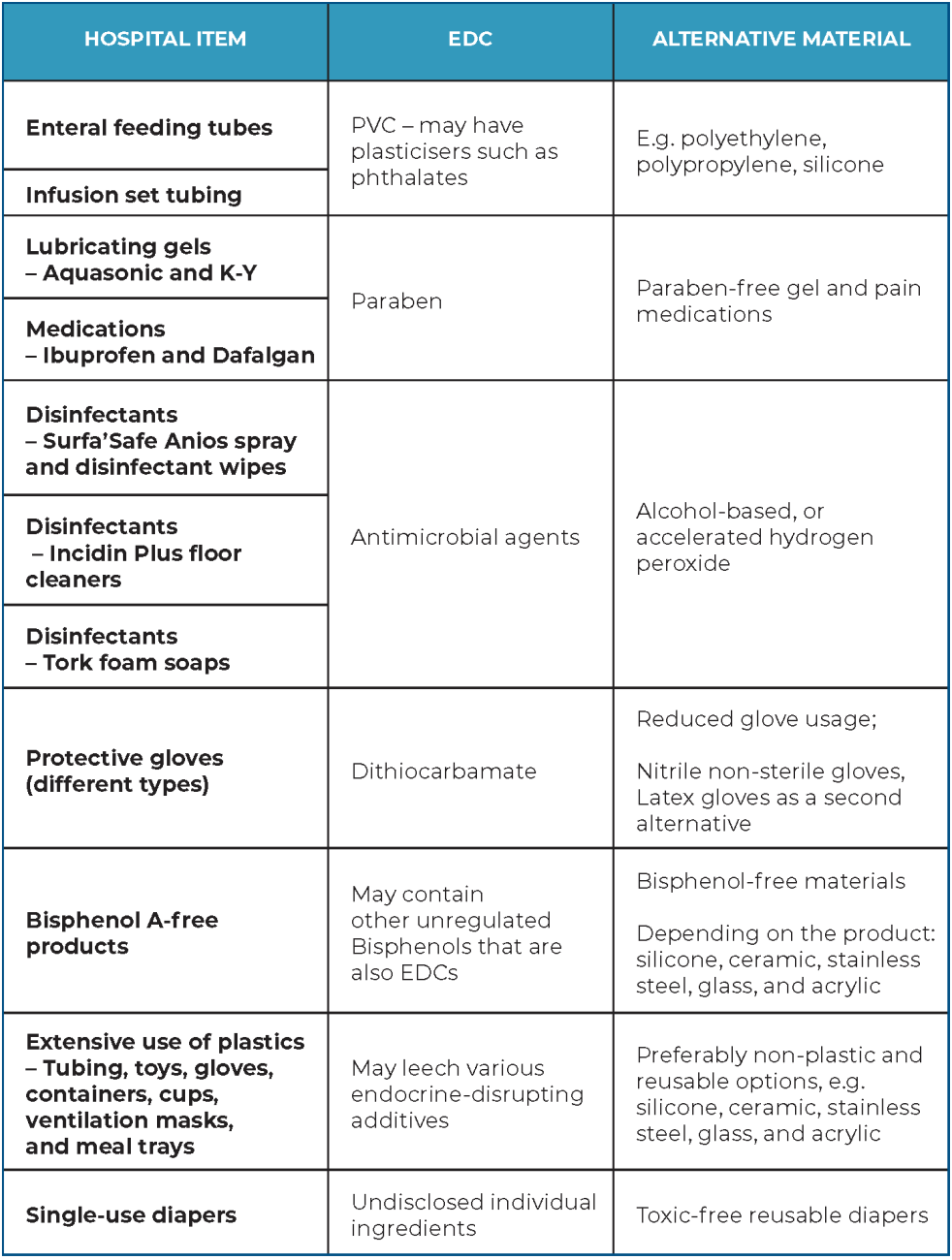
A blog post by Akif Görgülü,
Chemicals & Plastics Policy Coordinator - HCWH Europe
Last updated: 6 August 2024
Several harmful chemicals used in healthcare products in maternity and paediatrics wards were identified in a Brussels hospital through the AHIMSA project led by Hainaut Analyses and Société Scientifique de Médecine Generale. This discovery emphasises the urgent need for the healthcare sector to transition towards toxic-free practices.
Endocrine-disrupting chemicals and health
The healthcare sector inadvertently contributes to environmental and health risks by using products containing harmful chemicals, including endocrine-disrupting chemicals (EDCs). These disruptors cause adverse health effects, such as reproductive, neurological, and developmental disorders. They can be found in various products, including medical devices and textiles, disinfectants, and plastics.
Exposure to EDCs in healthcare settings occurs through inhalation, absorption, and ingestion when they leach from medical devices or consumable products, sprays such as disinfectants, or product-to-skin contact. Medical devices can be a significant source of exposure to harmful chemicals yet remain exempt from chemical restrictions.
The EU healthcare system constitutes about 15,000 hospitals and accounts for almost 16% of all the EU’s public spending and 11% of the annual GDP in 2023. It is imperative that healthcare systems transition to a toxic-free circular economy, leveraging the healthcare sector’s market influence to eliminate EDCs. Medical procurement teams hold significant power and can ask suppliers for information about products and their manufacturing process. HCWH Europe has developed a phase-out list for chemicals of concern in partnerships with leading healthcare procurement organisations to pave the way for sustainable procurement.
Harmful chemicals in maternities
An increase in endocrine-associated paediatric disorders has been observed in the past two decades. Newborns and infants are particularly vulnerable, and their EDC exposure can be 10-100 times higher than the general population due to their low body weight, greater skin-to-body ratio, and developing organs. Newborns are further exposed to harmful chemicals via plastics, such as polyvinyl chloride (PVC), in medical devices.
As part of the Greening the Brussels healthcare sector project, HCWH Europe analysed the AHIMSA data and provided recommendations to the Brussels hospital based on the products from the maternity and paediatric wards found to have EDCs. These chemicals were found in various products, including feeding tubes, medications, protective gloves, cleaning products, toys, and diapers. The investigation sheds light on the urgent need for healthcare organisations to transition towards sustainable practices to improve patient health. The hospital identified various harmful chemicals found in healthcare products, including PVC, parabens, dithiocarbamate, and disinfectants. The table below lists each chemical alongside its adverse health effects and safer alternatives.

The way forward
The first step in solving any problem is recognising there is one. The hospital has taken a critical first step in achieving a safer healthcare environment by identifying harmful chemicals in their wards, and many other hospitals are taking similar proactive steps. To catch up with current environmental goals, chemical regulations need to be stricter and apply a precautionary approach when it comes to harmful chemicals found in the healthcare sector. Ahead of the European Commission’s revision of the REACH (Registration, Evaluation, Authorisation, and Restriction of chemicals) regulation, HCWH Europe is running a petition to ban PVC in collaboration with other NGOs.
Key recommendations for a circular healthcare sector
- Prioritise the identification and substitution of the most harmful chemicals.
- Empower procurement teams to make sustainable choices on plastics and EDCs.
- Increase staff and patient awareness of the risks of plastics and EDCs.
- Promote the use of safe, reusable items to reduce waste and costs.
- Demand transparency from manufacturers regarding chemicals in products and the supply chain.
- Advocate the health of patients, staff, and the environment while recognising the role of healthcare in building a sustainable future.
Toxic-free, sustainable healthcare practices
Despite well-documented links between EDCs and various health issues, these harmful chemicals persist in healthcare products. Plastics, commonly used in medical devices, disinfectants, and textiles, are a major source of concern. Regulations to combat these chemicals are either delayed or inadequate, posing risks to patients, healthcare workers, and the environment.
The healthcare sector must lead the charge in transitioning to a circular, sustainable, and toxic-free economy. The Brussels hospital's initiative sets a precedent for other healthcare organisations to follow suit, emphasising the need for transparency, awareness, and sustainable procurement practices. Particularly where it concerns vulnerable groups such as children, the healthcare sector can and must champion a safer and greener future for all.
Interested in more stories like this?
Sign up to HCWH Europe’s Circular Healthcare newsletter.